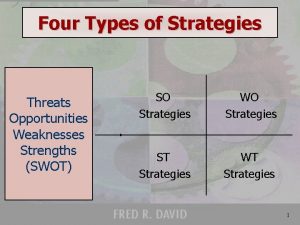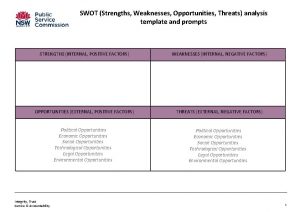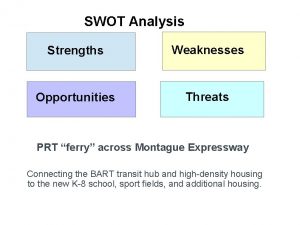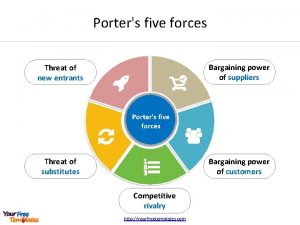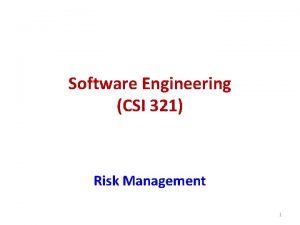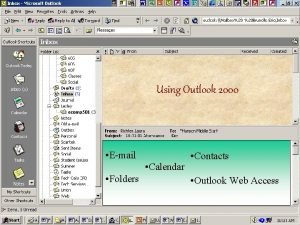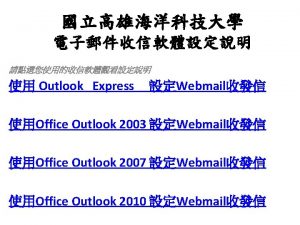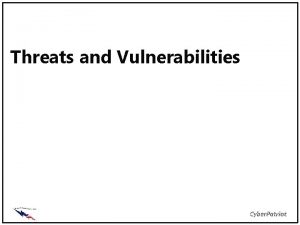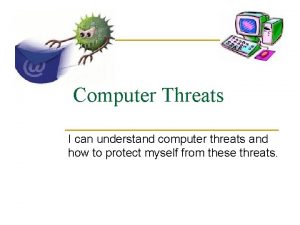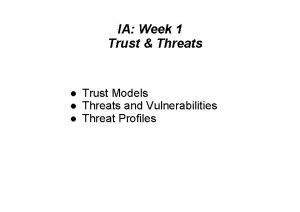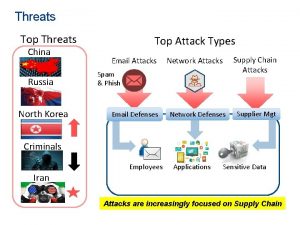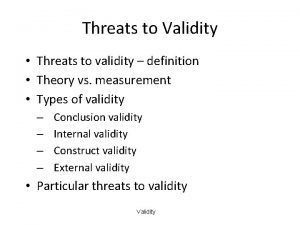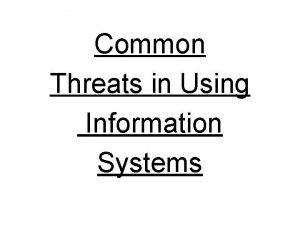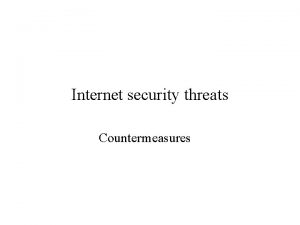On the History Threats and Future Outlook of












































- Slides: 44

On the History, Threats, and Future Outlook of GPSDECLASSIFIED. COM

Scope of book § GPS Declassified examines the development of GPS from its secret, Cold War military roots to its emergence as a worldwide consumer industry and vital public utility. § We briefly look back at the history of navigation and forward to the likely near-term future of GPS and GNSS systems

Why did we write this book? § To fill a gap in the literature by assimilating elements of the GPS story scattered among often obscure sources § To address numerous misconceptions and myths § To raise awareness of the vast non-military reliance on GPS in hopes of encouraging broader policy engagement by the general public

Major takeaways § Space tracking led directly to satellite navigation/GPS § GPS is the most important navigational advance since John Harrison invented the marine chronometer (~1761) § Positioning, Navigation & Timing (PNT) are now critical to commerce and daily civilian life, making GPS a vital public utility for users worldwide

Test Your GPS IQ: True of False? 1. DARPA invented GPS. 2. Ronald Reagan declassified GPS for civilian use in 1983. 3. Global synchronized time was an unexpected consequence of GPS. 4. The U. S. government alters GPS signals during terrorist alerts. 5. The number of users today threatens to overwhelm GPS capacity.

Presentation Overview § GPS, a technology invented in U. S. military laboratories, revolutionized war-fighting weapons, tactics and strategy. § Contrary to common misconceptions, GPS development envisioned non -military uses from the start. § GPS spawned complementary/competing systems worldwide and became integral to commercial, scientific and civilian activities. § Its global impact today is greater than most people realize, and GPS has become an unseen but critical component of modern infrastructure.

Roger L. Easton (1921 -2014) § Naval Research Lab: 1943 -1980 § Conceived Timation: 1964 § Distinguished Civilian Service Award: 1960 § National Medal of Technology: 2004 § Inventors Hall of Fame: 2010

December 6, 1957 Vanguard TV-3 explodes on takeoff Credit: Richard D. Easton Vanguard TV-3 satellite survived. On display at the National Air & Space Museum.

March 17, 1958 Vanguard 1 lifts off Credit: NRL Vanguard I, still orbiting, is the oldest man-made object in space Credit: Easton family photo Easton children at home gathered around the Vanguard 1 satellite shortly before its launch

March 2008 – Vanguard 50 th anniversary celebration Vanguard TV-3 satellite reopened at National Air & Space Museum Credit: Roger Easton Jr.

The path to satellite navigation § Ancient: Visual aids Landmarks: rivers, mountains, coastlines, vegetation, man-made Celestial objects: the Sun, Moon, planets, North Star, constellations § Compass (200 B. C. ) First technology to use an invisible direction-finding aid § Navigating at sea required technological advances Astrolabes, sextants, telescopes, astronomical charts Accurate clocks (marine chronometer) to solve longitude problem § Discovery of high-frequency electromagnetic waves (1800 A. D. ) Radar, radio, etc.

Navigation precision a century ago Sir Ernest Shackleton (1874 -1922) 1916 Voyage of James Caird Shackleton’s navigator, Frank Worlsey, told him that he “could not be sure of our position to ten miles. ”

Foresight Arthur C. Clarke, best known for 2001: A Space Odyssey, made a surprisingly accurate prediction of GPS in an August 5, 1956, letter to his friend Andrew G. Haley: “Perhaps in 30 years…three stations in the 24 -hour orbit…make possible a position-finding grid whereby anyone of earth could locate himself by means of a couple of dials on an instrument about the size of a watch”.

The path to satellite navigation After the Soviet Union launched the first satellite, Sputnik, in 1957, three individuals or groups that tracked it later proposed satellite navigation systems based on: Inverting the tracking process Using receivers to track the position of satellites Using satellites to determine the position of receivers

The path to satellite navigation “To my knowledge the idea of using passive ranging as a navigation technique was a result of a conversation between myself and Dr. Arnold Shostak of ONR [Office of Naval Research] in [April] 1964. “Dr. Shostak was explaining how the hydrogen maser worked and obtained its fantastic time keeping ability. At the time I remarked that this device appeared to make passive ranging feasible. He agreed, and I spent a week working on the idea. ” — from a slide presentation by Roger Easton, 1967

The path to satellite navigation Minitrack First satellite tracking system, designed for Vanguard Rocket Program The network of primary Minitrack stations as of January 1957 Source: Vanguard: A History, NASA Tracking Station at Blossom Point, MD. Note the north-south and east-west antenna configuration Source: NRL Roger Easton taking Minitrack data Source: NRL

The path to satellite navigation Credit: NRL graphic Space Surveillance System (original space “fence” 1958 - 2013) Tracking Station Transmitter Lake Kickapoo Texas

The path to GPS U. S. Pre-GPS Space-Based Navigation Proposals § Angle Measurement (position in sky) • Edward Everett Hale, “The Brick Moon, ” 1870 § Doppler Measurement (change in pitch of signal) • Lovell Lawrence Jr. , “Navigation by Satellites, ” Missiles and Rockets, 1956 • Transit, George Weiffenbach and William Guier, Applied Physics Laboratory, 1958 § Range Measurement (difference in time of arrival of signals) • • • Don Williams, Hughes Aircraft, 1959 SECOR (sequential correlation of range), Army, 1961 Roy Anderson, GE/NASA, 1963 Timation (time navigation), Roger Easton, Naval Research Laboratory, 1964 621 b, Air Force/Aerospace Corporation, 1964

The path to GPS The Joint Chiefs of Staff’s Navigation Study Panel (1968) specified that the Defense Navigation Satellite System (replacement for Transit) provide: § three-dimensional § instantaneous § worldwide fixes § within a specified accuracy (50 feet? ) 4/17/73 – Joint Program Office established with the Air Force as the lead service. Col. Brad Parkinson led it from 1973 -78 Credit: U. S. Air Force

‘The Time Web’ “Precise orbiting clocks will prove to be a valuable tool in a variety of applications, by providing the entire planet earth with a single, accurate time system, enveloping the globe in a web of synchronized satellite signals. ” — Roger Easton, quoted in article, “The Time Web, ” by Nathan Eberhart, Science News, July 13, 1974

From Timation to GPS § Timation III, renamed NTS-1: First satellite launched by JPO, carried first atomic clocks to space in 1974. § NTS-2, the renamed Timation IV satellite: Carried first cesium atomic clock into orbit in 1977. § NTS-2 plus three later Navigation Development Satellites formed the first GPS constellation, successfully giving users longitude, latitude, altitude and time § GPS Block I, first operational satellites o Launched 1978 – 1985 o 11 satellites, all retired (SVN 7 failed) Credit: NRL graphic

Capability of GNSS receivers § Based on analysis of ~400 receivers, chipsets, and modules offered by top 31 global companies. § GNSS devices in use worldwide in 2015: 4. 5 billion (est. ) Source: GNSS User Technology Report, Issue 1, copyright © European GNSS Agency, 2016, www. gsa. europa. eu

Supported constellations by receivers Receivers supporting all four GNSS signals are growing rapidly, and now account for 30 percent of products offered by the top 31 companies. Source: GNSS User Technology Report, Issue 1, copyright © European GNSS Agency, 2016, www. gsa. europa. eu

Dual-use: built in from the start “The P Signal is used by the precision military user and will resist jamming, spoofing, and multipath and will be deniable to unauthorized users by employing transmission security (TRNSEC) devices. The C/A Signal will serve as an aid to the acquisition of the P Signal, and will also provide a navigation signal in the clear to both the military and civil user. ” — page 30, Navstar Global Positioning System Program Management Plan, July 15, 1974

GPS civilian debut: land surveying, 1982 Macrometer V-1000 § 160 lbs. (plus tripod antenna, 40 lbs. ) § 22 in. wide, 26 in. deep, 26 in. high § Used in pairs § $250, 000 each § Recorded data for about four hours a day while 6 satellites were overhead Credit: By Kenneth Fiske, Creative Commons

Soviets shoot down KAL 007, Sept. 1, 1983 “… the President has determined that the United States is prepared to make available to civilian aircraft the facilities of its Global Positioning System when it becomes operational in 1988. …” — Larry M. Speakes, deputy press secretary, Sept. 17 Credit: By Mgarin 73 – Wikimedia Commons

Challenger explosion, Jan. 28, 1986 § Grounding of Space Shuttle program set back GPS launch schedule by about two years § Air Force developed Delta II rocket, which carried GPS II satellites into orbit from 1989 to 2009 Credit: NASA

GPS military debut: Persian Gulf War, 1990 -91 August 2, 1990 § Iraq invaded Kuwait § United States launched GPS SVN 21 bringing constellation size to 14 satellites October 1, 1990 § United States launched GPS SVN 15 November 26, 1990 § United States launched GPS SVN 23 bringing constellation size to to 16 satellites Ground crews made complicated adjustments to optimize the incomplete system and overcome technical problems Map Source: Wikimedia Commons

GPS military debut: Persian Gulf War, 1990 -91 Operation Desert Storm § Receiver shortage throughout war – total of 4, 490 commercial vs. 842 military § Selective Availability turned off § Enabled navigation across the featureless desert § Atomic clock time used to sync helicopter attack on two targets within 20 seconds apart § Coordinates used for dropping glow sticks at launch point for missiles § Helped to avoid fratricide § Improved search and rescue Source: By Jeff Dahl - Wikimedia Commons § Better navigation to launch points improved effectiveness of conventional weapons

GPS military debut: Persian Gulf War, 1990 -91 “GPS was used more extensively than planned and met navigation and positioning requirements…. GPS should be considered for incorporation into all weapon systems and platforms. ” —Conduct of the Persian Gulf War, Final Report to Congress, U. S. Department of Defense, 1992

GPS reliance now “The increasing convergence of critical infrastructure dependency on GPS services with the likelihood that threat actors will exploit their awareness of that dependency presents a growing risk to the United States. ” — National Risk Estimate, Risks to U. S. Critical Infrastructure from GPS Disruptions, U. S. Department of Homeland Security, 2012

How did the public become reliant on a military system? § § § § Miniaturization, fusion of microelectronics and GPS receivers Decision in mid-1990 s that GPS would remain under military control Improved accuracy, including differential augmentation (DGPS) Turning off Selective Availability Integration with consumer electronics Need to locate wireless 911 emergency calls Benefits of precise timing signals across many industries

The incredible shrinking GPS receiver… Credit: Courtesy of Rockwell Collins 1976 -77 Generalized Development Model by Rockwell Collins Credit: Courtesy of Rockwell Collins 1980 Manpack GPS receiver by Rockwell Collins Credit: Courtesy of Texas Instruments 1981 -82 TI 4100 and antenna by Texas Instruments

The incredible shrinking GPS receiver… Credit: U. S. Army Heritage Museum 1988 Trimpack GPS receiver by Trimble Navigation Credit: Courtesy of Rockwell Collins 1990 Portable Lightweight GPS Receiver (PLGR AN/PSN-11) by Rockwell Collins Credit: U. S. Army Heritage Museum 1993 Mayo Foundation/Motorola Multi-chip Module (pictured beside 3 -inch ruler)

The incredible shrinking GPS receiver… Credit: By Humberto Möekel – Wikimedia Commons 2007 Garmin Nüvi 200 Credit: By Wolf Gang – Creative Commons 2008 Apple i. Phone 3 G Credit: Courtesy Origin. GPS 2016 Origin. GPS Nano Spider (4. 1 mm x 4. 1 mm)

Civilian, scientific, and commercial activities that use GPS: § § § aviation and aerospace trucking and shipping fleet management railroads fishing and boating surveying and mapping agriculture and forestry mining and oil exploration grading and construction environmental protection earthquake monitoring § wildlife management § recreation (golf, hiking, running) § law enforcement (tracking stolen items, monitoring probationers, parolees) § emergency response § monitoring pets, children, Alzheimer’s patients § telecommunications and data systems § banking and financial networks § electric power grids § location-based services

Civilian, scientific, and commercial activities that use GPS: Monitoring physical structures By Leica Geosystems AG – Wikipedia Monitoring people By Jérémy-Günther-Heinz Jähnick - Wikimedia Commons Precise timing By Yann Forget -Wikimedia Commons

Economic Impact § 2019 RTI International Study commissioned by NIST. § 10 key industries have generated $1. 4 T of benefit. About 90% has been after 2010. § GPS outage could have an impact of $1 B per day. If the outage occurred during critical planting seasons for farmers, the impact could be as high as $45 B.

GPS as a dual-use, military-civilian system Advantages Challenges § Military status enhances likelihood of sustained funding § Military status reduces public awareness of GPS and civilian policy issues § A separate civilian system would still require military protection § Civilian and military needs and objectives may differ or conflict § Security drives development. GPS more secure than Internet. § National security strategy must factor loss of a public utility, not merely a military asset

GPS is Easy to Hack, and the US Has no Backup – Scientific American, December 1. 2019 § Signal is easy to jam – drown out with meaningless noise § Easy to spoof – stronger “false” signal § 1997 James Bond film “Tomorrow Never Dies” § 2004 Presidential directive to build a backup § Solution – e. Loran

Enhanced Loran § Operates in the 90 -110 k. Hz frequency band § Builds on Loran-C § Has been implemented in China, Russia and Western Europe § Develop improved inertial navigation

Conclusions § GPS is an indispensable military asset § GPS is a vital public utility § Civilians cannot afford to take GPS for granted, and broader public policy engagement is needed Credit: U. S. Government, gps. gov

Test Your GPS IQ: True of False? 1. DARPA invented GPS. 2. Ronald Reagan declassified GPS for civilian use in 1983. 3. Global synchronized time was an unexpected consequence of GPS. 4. The U. S. government alters GPS signals during terrorist alerts. 5. The number of users today threatens to overwhelm GPS capacity.

Questions?
 Future perfect form
Future perfect form Future perfect e future continuous
Future perfect e future continuous Outlook for incentive travel
Outlook for incentive travel Outlook capg
Outlook capg Future perfect and future continuous examples
Future perfect and future continuous examples Perfect infinitive
Perfect infinitive Future plans and finished future actions
Future plans and finished future actions Future continuous
Future continuous Nulti i prvi kondicional
Nulti i prvi kondicional Wireless security threats and vulnerabilities
Wireless security threats and vulnerabilities Wt strategies
Wt strategies Cyber security threats and countermeasures
Cyber security threats and countermeasures Malicious attacks threats and vulnerabilities
Malicious attacks threats and vulnerabilities Factbranch
Factbranch Opportunities and threats of a teacher
Opportunities and threats of a teacher Opportunities and threats of a teacher
Opportunities and threats of a teacher Opportunities and challenges in media and information
Opportunities and challenges in media and information Strengths opportunities threats weaknesses
Strengths opportunities threats weaknesses Virus and related threats
Virus and related threats Expenditure cycle threats and controls
Expenditure cycle threats and controls Opportunities and threats of a person
Opportunities and threats of a person List of opportunities of a student
List of opportunities of a student Workstation domain risks threats and vulnerabilities
Workstation domain risks threats and vulnerabilities Perfect future
Perfect future Have en futuro simple
Have en futuro simple Future nurse programme
Future nurse programme Future simple vs future continuous
Future simple vs future continuous Present continuous and going to for future plans
Present continuous and going to for future plans Major threats to biodiversity
Major threats to biodiversity Desert biome threats
Desert biome threats Threats to biodiversity a case study of hawaiian birds
Threats to biodiversity a case study of hawaiian birds Strengths opportunities threats weaknesses
Strengths opportunities threats weaknesses Threats of new entrants
Threats of new entrants Automated threats
Automated threats Erving goffman face theory
Erving goffman face theory Folk cultural landscape
Folk cultural landscape Impending danger threats
Impending danger threats Coral reef new caledonia
Coral reef new caledonia School threats examples
School threats examples Ccna security chapter 1
Ccna security chapter 1 Accounting
Accounting Threats posed to networks
Threats posed to networks Systematic attempt to specify threats to project plan
Systematic attempt to specify threats to project plan A systematic attempt to specify threats to the project plan
A systematic attempt to specify threats to the project plan Hudhud chants of the ifugao threats
Hudhud chants of the ifugao threats










